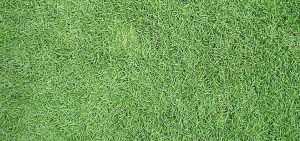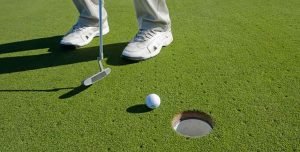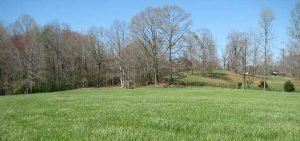Golf courses have lush, manicured lawns that provide an ideal playing surface for golfers. Yet, what kind of grass is used on golf courses?
Choosing the grass for a golf course is a complex process that involves careful consideration of playability, durability, and maintenance needs.
In this context, it is essential to understand the different types of grass commonly used on golf courses and their unique characteristics.
This article will explore the most common grasses for golf courses. Let’s scroll down to discover in detail!
What Kind Of Grass Is Used On Golf Courses?
Bermuda grass is a common warm-season grass used on golf courses due to its durability and ability to recover quickly from damage.
Other grass types used for cooler climates include:
- Bentgrass
- Fescue
- Zoysia
- Poa annua
- Rye
Bermuda

Grass on Golf Courses
Bermuda grass is a popular choice for golf courses around the world. This warm season grass is durable, resilient, and can withstand heavy traffic. Therefore, it is ideal for golf courses.
Besides, it is drought-tolerant and can survive in a variety of soils. So it becomes an excellent choice for areas with hot and humid climates.
The advantage of Bermuda grass on the golf course is its ability to recover from damage. This feature allows course managers to maintain green and healthy year-round, even in high-traffic areas.
But Bermuda grass needs regular maintenance and care, such as:
- Mowing the lawn regularly
- Fertilization
- Aeration
It can become patchy and thin and has disease without proper care.
Bentgrass

Bentgrass
This grass has a fine texture and dense growth pattern. Thus, it creates a flat and smooth playing surface.
First, it can withstand close cutting. This feature allows course managers to maintain a short, even-cut height. It is essential for hole placement.
Second, it is highly tolerant of low light conditions. So it is ideal for patios with shaded areas. But it needs regular irrigation and fertilization. With proper care, it can create a beautiful and healthy walkway.
Third, it is prone to diseases, especially in hot and humid weather. Hence, it can lead to patches of browning and thinning, requiring regular monitoring and treatment.
Bentgrass is suitable for golf courses in cooler climates, especially lawns.
Fescue

Cool Season Grass
Fescue is a cool season grass commonly used on golf courses. You will find it in regions with mild temperatures and humid climates.
This grass has a good texture and low growing habit. Hence, it can produce firm, fast-playing surfaces on rough and ball-rolling tracks.
One benefit of Fescue grass on the golf course is its low maintenance requirements. Specifically, it can tolerate occasional watering and fertilizing. Hence, it becomes an eco-friendly, easy-care option.
Besides, Fescue can be highly drought tolerant. It can withstand prolonged dry weather without patching or turning brown. So you can use it in areas with limited rainfall or water resources.
Yet, like Bentgrass, small Fescue can be susceptible to disease, especially in wet weather. Besides, it can be challenging to set up and maintain, requiring careful monitoring and management.
Zoysia

Warm-season Grass
Zoysia grass is a warm-season grass that is gaining popularity on golf courses, especially in the southern regions of the United States. This grass has quite similar properties to Bermuda.
Besides, it can provide a consistent playing surface throughout the year. Also, it maintains a green color in the fall and requires less water and fertilizer than other grasses.
In addition, Zoysia grass has a high shear tolerance. So it becomes the ideal choice for the ball and rough roads. It creates a dense, tight turf that can withstand the wear and tear of constant play.
But Zoysia grass can grow slowly and needs more maintenance than other grasses. It is dormant in winter, turning brown and losing its lush green color.
Poa Annua

Green-annual Grass
Poa Annua (green-annual grass) is a cool-loving grass commonly found on golf courses, especially in areas with mild temperatures and high humidity.
It has a smooth texture and a bright green color. So it becomes attractive to use on the putting greens.
Besides, it can germinate quickly. Hence, it allows for the quick setup of new turf. Also, it has a high tolerance for low mowing heights, making it ideal for lawns. We recommend the best mower for old ladies for this grass.
But Poa Annua grass can be difficult to maintain due to its susceptibility to disease, especially in hot and humid weather. Besides, it has a shallow root system to make it susceptible to drought.
Rye

Rye
This grass is ideal for monitoring during the fall and winter months. One of the benefits of Rye grass on a golf course is its ability to provide a lush green playing surface during the winter months when the warm season grass is dormant.
But it may need to be mowed and fertilized more often than other grasses. Besides, it is susceptible to diseases in warm and humid weather.
What Is The Grass Around A Golf Hole Called?
The grass around the hole is a putting green, which players attempt to complete by putting the ball in a cup. It can affect a player’s score, so it is specially maintained.
The putting green is smaller than others and is round or elongated. Besides, the grass on the putting green is fine-leaved grass, such as Bentgrass or Poa Annua.
These grasses can withstand very close cutting heights and provide a smooth, even surface for the putting green. They need careful maintenance and management. The goal is to make sure they stay healthy and playable.
How To Create A Golf Course Grass At Home?

Golf Course Grass At Home
Creating golf grass at home can be a challenging yet rewarding project for golf enthusiasts who want to practice their game. For some, it’s simply enjoying a manicured lawn. Here are some steps to help you create golf grass at home:
- Choose the grass: Different types of grass on the golf course depend on the climate and soil type. Research and choose the most suitable grass for your location.
- Soil Preparation: Clear the area of debris or rocks and level the ground. Add organic matter such as compost or peat moss to improve soil quality.
- Sowing: Follow recommended seeding rate and seeding depth for your chosen weed. Water thoroughly and cover with a layer of straw to help retain moisture and protect the seeds from birds.
- Water regularly: Keep the area moist until the grass is full. This process may need daily watering or more, depending on weather conditions.
- Fertilize: Fertilize the area evenly according to the schedule recommended for your grass type.
- Mow regularly: Once the grass is full, mow the lawn regularly to maintain the desired height. We recommend using the best mowers for thick lawns with sharp blades to avoid damaging the grass.
- Maintenance: Golf grass needs regular maintenance, including watering, fertilizing, and aeration. Besides, it may require occasional treatment for pests.
Creating golf grass at home requires patience, dedication, and constant maintenance. Yet, with proper preparation and care, you can enjoy a beautiful, playable lawn. Hence, it can rival professional golf courses.
Conclusion
What kind of grass is used on golf courses? Each grass has pros and cons, from warm-season Bermuda grass to cool-season Bentgrass, Fescue grass, Zoysia grass, Poa Annua grass, and Rye.
Golf course managers and supervisors must carefully select and maintain turf to ensure optimal playability, durability, and aesthetics.
By understanding the different types of grass used on a golf course and their characteristics, golfers can deepen their understanding of the complex science and art of golf management.
Thanks for reading!






